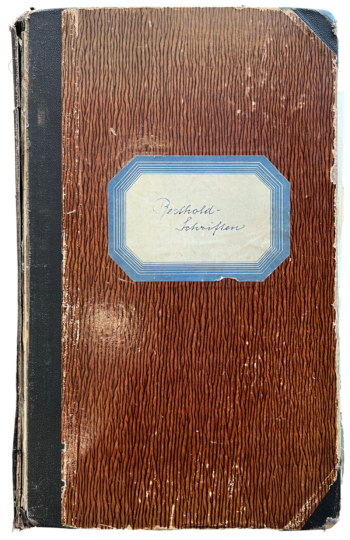In June, on my way to the Historical Archive at the Deutsches Technikmuseum in Berlin, an art historian sent me a message about a handwritten notebook that might have some information about Berthold’s patented type designs. After consulting it, I found that it did include details for many of the company’s design-patent registrations and several other kinds of information. As a reference, the notebook is sensational. It seems to have been an internal type-size registry. Today, there is a similar record book from the D. Stempel AG at the Haus für Industriekultur in Darmstadt. Another has survived from the Lettergieterij ‘Amsterdam’. Records of this kind must also exist for other foundries, yet those are my known examples.
The Deutsches Technikmuseum’s Historical Archive keeps the notebook in its Möllenstädt Collection. Its reference number is SDTB/Hist. Archiv I.4.327 0038 NL Möllenstädt. A handwritten title on the cover reads Berthold-Schriften. I don’t know whether it was the official notebook at Berthold. Yet, it lists the origins of most company typefaces offered for sale between the early 1890s and around the 1950s, including border-printing and wood type fonts. The entries captivate me. For instance, the notebook provides an internal source proving that Bauer & Co. created the original Akzidenz-Grotesk typeface, not Berthold in Berlin or any other foundry (including Böttger, Poppelbaum, Theinhart, etc.). The notebook also suggests that D. Stempel AG made the patterns for many of Berthold’s wood-type fonts.
Update from 18 November 2023: Recently, the Deutsches Technikmuseum’s Historical Archive digitized the notebook mentioned above. Now, you can look through all of its pages digitally at museum-digital.de! Thanks to the CC0 license, the images are free for download and reuse. All the notes on loose sheets of paper preserved inside the notebook were also digitized. Online, they appear after the notebook’s back cover. Make sure not to miss them.
A quick Berthold refresher
The Berthold typefoundry grew out of many other companies. Yet, that was probably not Hermann Berthold’s initial plan. He established an electrotyping in 1858, the Institut für Electro-Typie. From 1861 until 1865, he was a part-owner of the Zechendorf & Berthold, a typefoundry and brass-rule-making firm. Hermann Berthold and Gustav Zechendorf went their separate ways after that, with Berthold concentrating on brass rule making. Zechendorf continued to manufacture type and brass rules for a few more years. His widow continued Zechendorf’s business after his death.
Berthold retired from his brass-rule company in 1888 and died in 1904. In 1893, his former business acquired Gustav Reinhold’s typefoundry. Reinhold had only set up his Berlin-based typefoundry in 1889, but he bought the Emil Berger foundry in Leipzig a year later. The Berger/Reinhold/Berthold foundry expanded rapidly and soon set up in St. Petersburg. That was the real beginning of the typefoundry we think of today when we hear the “Berthold” name. At the end of 1897, it purchased the Stuttgart and Düsseldorf-based Bauer & Co. typefoundry. At the turn of the century, it took over the Georg Ross & Co. foundry in St. Petersburg. Over the next few years, Berthold expanded to Vienna and Moscow. In 1908, Berthold acquired the Ferd. Theinhardt typefoundry in Berlin. Four years later, the company assumed control of the Flinsch foundry’s St. Petersburg location. Around the time the First World War ended, it purchased the Emil Gursch foundry in Berlin and several Leipzig foundries, too.
Berthold then set up a branch in Riga, which operated until 1937. It closed Bauer & Co. in Stuttgart in 1930 but reopened a Stuttgart factory following the Second World War. After the late 1950s, Berthold began to branch out into photo-typesetting, which must have become the company’s main focus by the late 1960s. Berthold stopped casting fonts of metal type in 1978. Matrices for several of its typefaces went to the Wagner foundry in Ingolstadt, which cast type until 2002. In 1967, Berthold opened a type-design office in Taufkirchen, outside Munich. The Berthold company filed for bankruptcy in 1993. Digital font files of Berthold’s typefaces for use without Berthold’s machines have been for sale – from one company or another – since 1991 (I am simplifying things here a bit). As I put my final touches on this post, Monotype announced that it had acquired Berthold’s [digital] “typeface inventory.”
Where does the Berthold-Schriften notebook come from?
The Berthold-Schriften notebook mentions the typefoundry sources for most fonts Berthold sold – at least until the early 1950s. It even notes the pages in Emil Berger and Bauer & Co. catalogs on which its older fonts appeared. From about 1900 until the end of its foundry-type era, almost all Berthold type designs were in-house creations. I have tabulated nearly all information from the notebook into Google Sheets (note that the Sheets file has 14 tabs!).
Due to the information at the beginning of the notebook, I believe its first author may have worked at Berthold’s St. Petersburg location. If the notebook was initially in Russia, it must have been brought to Berlin shortly afterward. On the inside back cover, someone wrote what must be either “5/4. 24 25 Dr. J.” or “5/4. 24 25 Dr. Z.” in pencil. “Dr. J.” could mean Dr. Oscar Jolles, who was Berthold’s director from 1899 until 1929. “Dr. Z.” could mean that the notebook was brought into the Direktorenzimmer on 5 April 1924 or 1925. Again, that would mean Oscar Jolles’s office.
The Berthold-Schriften notebook was kept in Berthold’s postwar company library under shelf number IX A-65. In the last few decades Berthold operated, the notebook may have been in the library at Berthold’s Taufkirchen location.
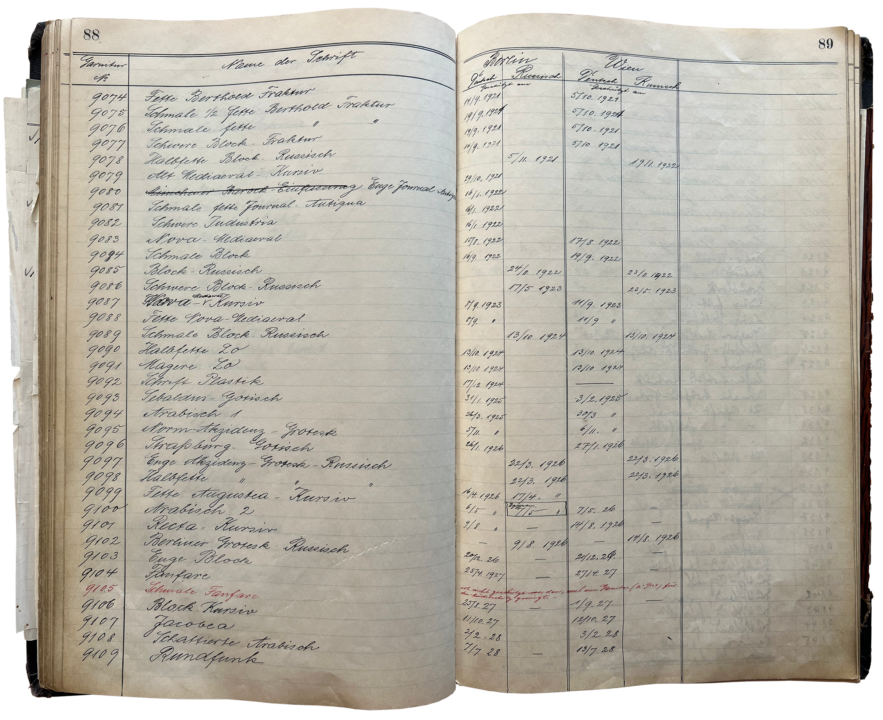
Spread listing Berthold’s Berlin and Vienna design-patent registrations from 14 September 1921 through 13 July 1928. From the Berthold-Schriften notebook, SDTB/Hist. Archiv I.4.327 0038 NL Möllenstädt, pp. 88–89.
Berthold’s patented type designs
In addition to the sources of its typefaces, Berlin-Schriften includes tables of typefaces’ design-patent registration information. The notebook is not a complete record of Berthold’s design patents. It does not include design patents Berthold registered before 1900, for instance. There is also a gap in design-registration records from 19 April 1907 to 14 September 1921. The last filing listed is from 23 January 1931, although Berthold probably continued to register its type designs until the 1980s or early 1990s. In Germany, during the decades this notebook was updated, notification of every design-patent registration was printed in an almost-daily government newspaper, the Deutscher Reichsanzeiger. The University of Mannheim has digitized that newspaper’s issues and created a partially-searchable database. That returns results for some of the information listed below. One can also use it to find information about typefaces Berthold filed for design patents before 1900, like Akzidenz-Grotesk.
Newspapers akin to the Deutscher Reichsanzeiger must have also been published in the other cities mentioned in the notebook’s design-registration records. However, I do not yet know what newspapers printed in Budapest, St. Petersburg, or Vienna included similar notices. The notebook even mentions that one Arabic-script typeface was registered in Egypt. Perhaps a newspaper there also ran a notice of Berthold’s filing.
What follows is not a list of all typefaces designed at Berthold between 1900 and 1931; that would be a much longer article. Instead, the following entries limit themselves to the typefaces with design registration information listed in the Berthold-Schriften notebook. Most links that are typeface names will take you to a full-page specimen recently digitized as part of the digiS-funded Berlin type specimen-digitization project.
Hercules (Samson) No. 1108–1116
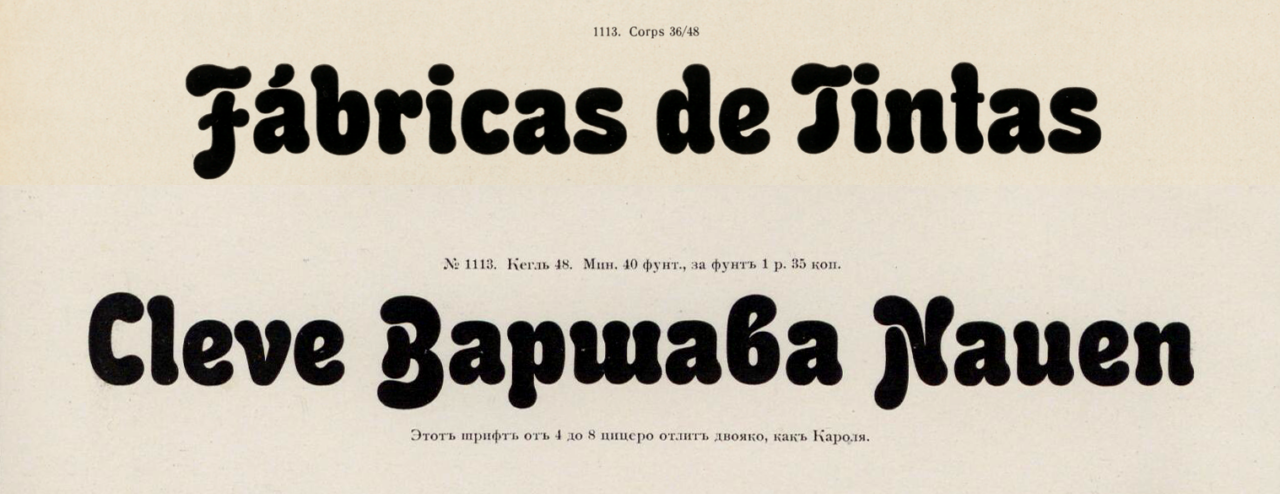
Herkules 36p on a 48p body.
According to the Berthold-Schriften notebook, Berthold registered Herkules’s 16–80p sizes in St. Petersburg on 13 September 1900. That filing, number 2690, was probably restricted to the typeface’s Cyrillic characters. In the notebook, the “Samson” appears in parentheses after “Herkules,” althought I have not seen a Cyrillic specimen for the typeface using that name. Although the Berthold-Schriften notebook does not include the date Berthold filed for German design patents on Herkules at the Berlin Muster-Register, other sources indicated that this took place – for the Latin-script characters – on 14 and 22 September 1899, and on 14 October 1899 (filing numbers 17477, 17490, and 17540). The Cyrillic registration took place in Berlin on 26 January 1900. Berthold also registered the design under name Carola Extended for sale in Great Britain and Ireland, although it does not seem to have marketed the design as part of a Carola-Grotesk “family” in Germany.
Intarsia (Veronika) No. 960–966
The Berthold-Schriften notebook does not include the 1899 dates when Berthold filed for German design patents on Intarsia at the Berlin Muster-Register, but FontsInUse.com provides that information. Thanks to the notebook, we know Berthold also registered Intarsia in St. Petersburg on 13 September 1900, where it was part of the same filing as Herkules, mentioned above. That was probably restricted to Intarsia’s Cyrillic characters, which Berthold sold under the name “Veronika.”
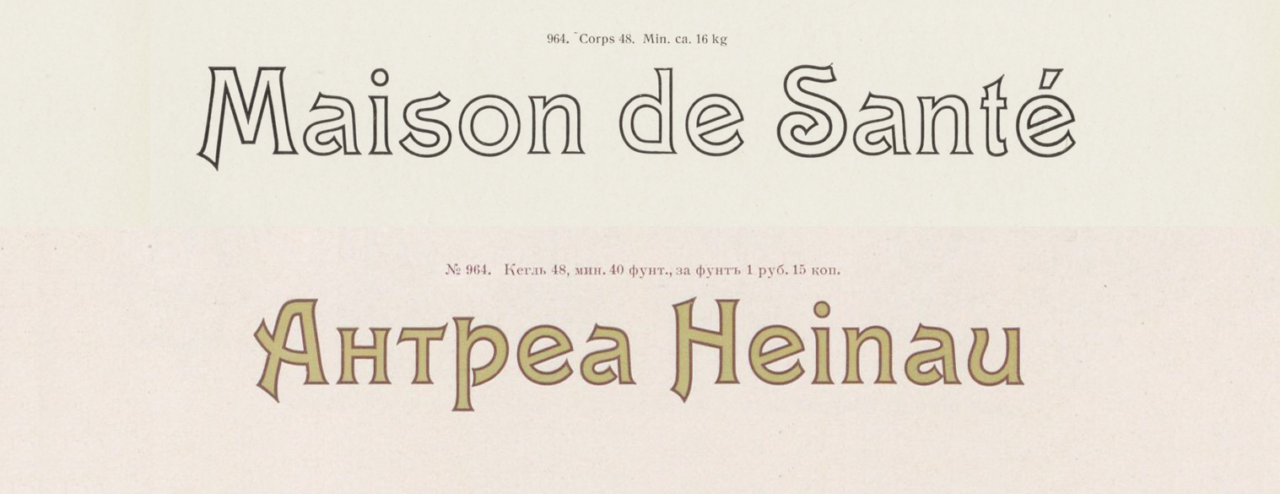
Intarsia 48pt. In the bottom row, the typeface is printed as a second layer over the related Constantia typeface. In Russia, Berthold sold this design under the name “Veronika.”
Carmen, halbfette No. 798–804
Halbfette Carmen is typeface that came to Berthold after it acquired the Stuttgart and Düsseldorf-based Bauer & Co. typefoundry in late 1897. While the Berthold-Schriften notebook does not include the date for the German design patent on its Latin-script characters, the Deutscher Reichsanzeiger notes that Bauer & Co. registered it with the Stuttgart Muster-Register on 27 June 1894. The Berthold-Schriften notebook records that H. Berthold AG registered Halbfette Carmen in St. Petersburg on 13 September 1900, in the same filing as Herkules snd Veronika, mentioned above. That filing was probably restricted to Halbfette Carmen’s Cyrillic characters.
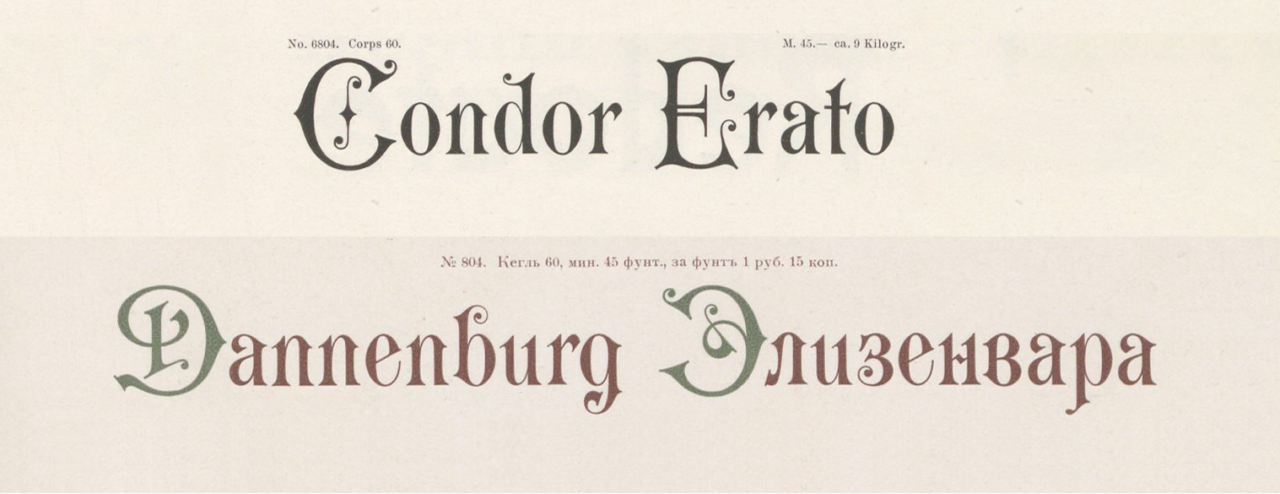
Halbfette Carmen 60p.
Rococo-Initialen, Serie XIII XIV
Along with Herkules, Veronika, and Halbfette Carmen, Berthold registered its Rococo Initials in St. Petersburg on 13 September 1900. Like the other typefaces, its filing for these initials was probably restricted to Cyrillic letterforms. The authors of the Berthold-Schriften notebook must have left the first X out of these series numbers when recording the St. Petersburg registration; the designs are Series XXIII and XXIV. For a better look, visit this Russian specimen. Although the Berthold-Schriften notebook does record it, Berthold filed for German design patents on the Rococco-Initialen at the Berlin Muster-Register on 27 Februar 1895.
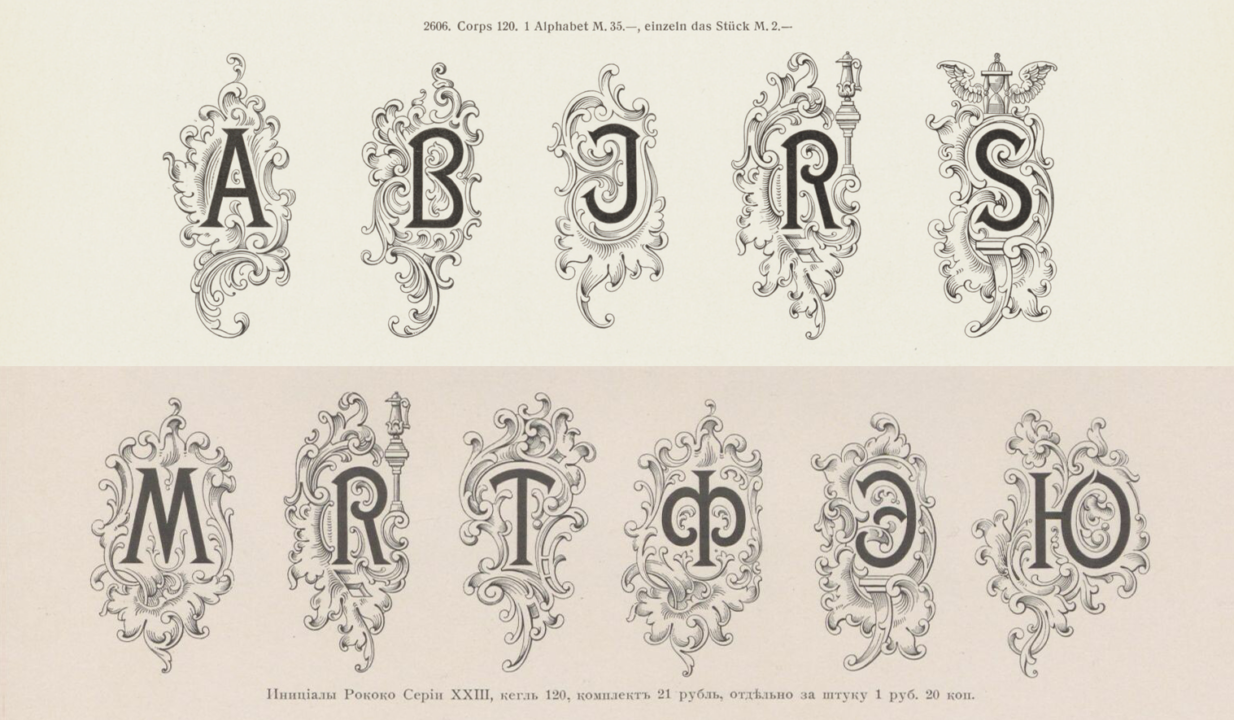
Rokoko-Initialen XXIII, 120p.
Lateinisch, Garnitur No. 27 Kegel 16–48
The Berthold-Schriften notebook does not include the date Berthold filed for German design patents on Lateinisch at the Berlin Muster-Register. Berthold registered Lateinisch’s 16–48p sizes in St. Petersburg on 16 January 1901. That filing, number 4193, was probably restricted to Lateinisch’s Cyrillic characters.
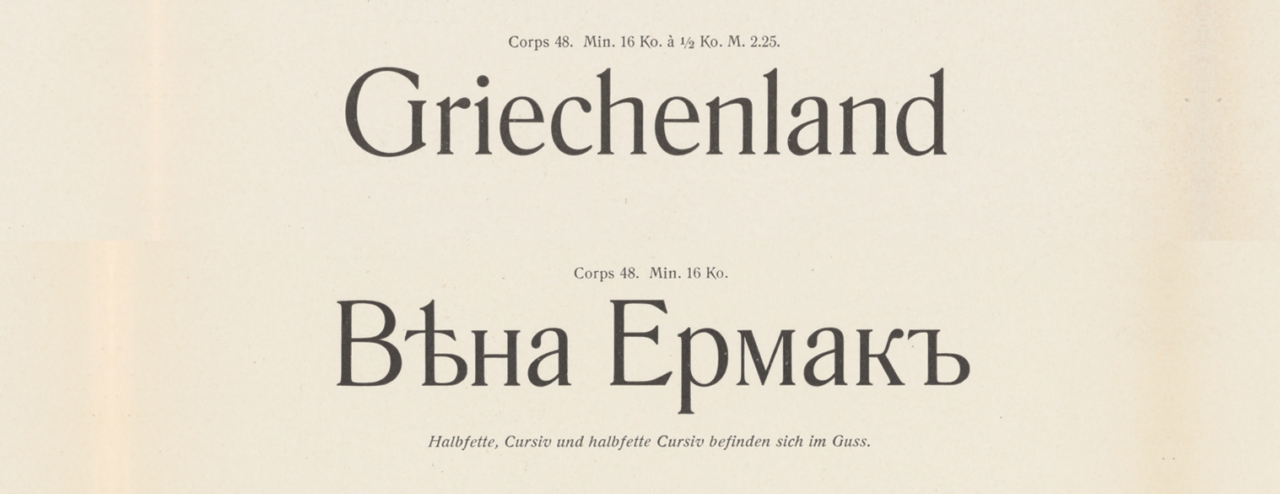
Lateinisch 48p.
According to Paratype, Literaturnaya – a revision of Lateinisch’s Cyrillic characters – “became the favorite text typeface of Soviet typography.”
Secession
Berthold filed Secession’s Latin-script characters with the Berlin Muster-Register for a German design patent on 3 April 1900. It registered Secession’s Cyrillic on 12 August 1901. Berthold filed for a Russian design patent in St. Petersburg on 30 July 1901, presumably just on the Cyrillic characters. For the typefaces published between about 1900 and 1921, Berthold had the same internal Garnitur and product numbers for its Latin and Cyrillic-script fonts. At Berthold, Secession had the internal Garnitur-Nummer 9001. According to another company notebook, Berthold registered the design in London on 29 May 1901 (R. 358021).
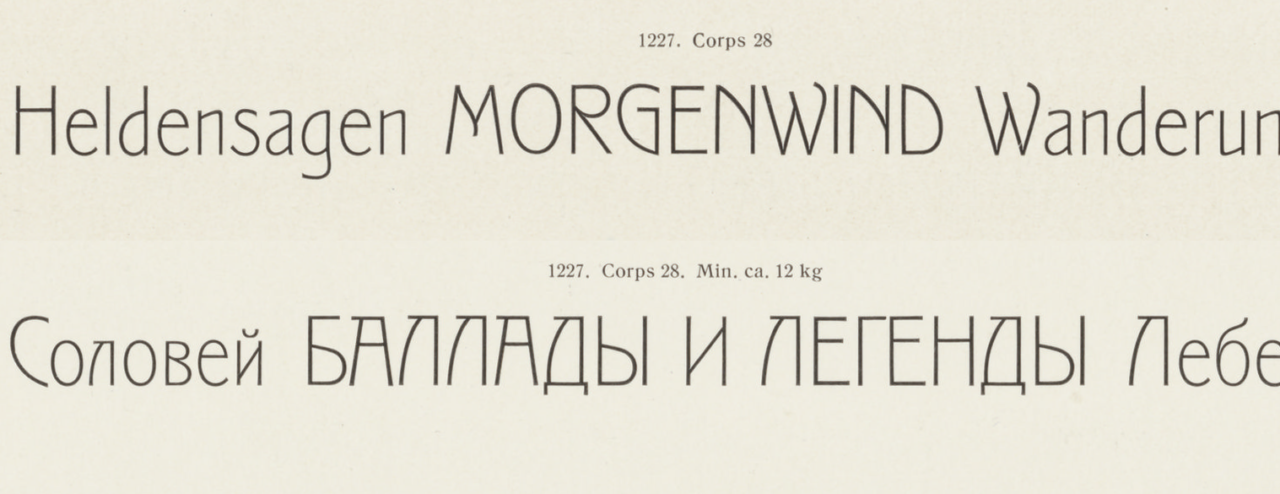
Secession 28p.
Halbfette Lateinisch-Cursiv
Berthold filed Halbfette Lateinisch-Cursiv’s Latin-script characters with the Berlin Muster-Register for a design patent on 22 December 1900. It registered the typeface’s Cyrillic on 26 April 1901. Berthold submitted the design in St. Petersburg on either 14 April 1901 as filing number 6543 or on 22 May 1901 (there are two different dates in SDTB/Hist. Archiv I.4.327 0038 NL Möllenstädt). The St. Petersburg registration may only have included the Cyrillic characters. At Berthold, Halbfette Lateinisch-Cursiv had the internal Garnitur-Nummer 9002.
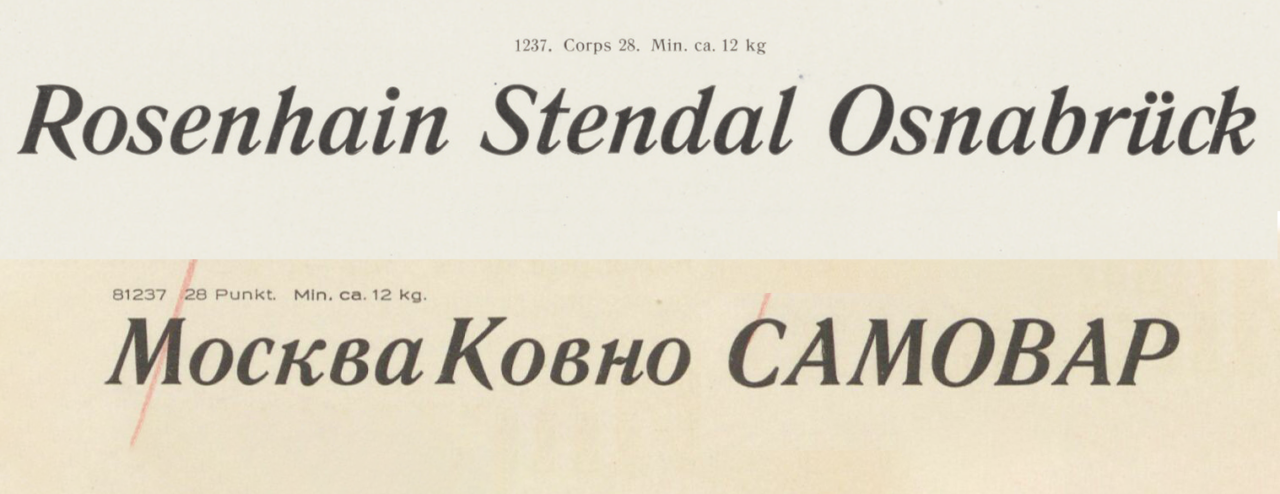
Halbfette Latinsch-Cursiv 28p.
Moderne fette Egyptienne
This Latin-script type design did not have a Cyrillic counterpart. Berthold received a German design patent on its Moderne fette Egyptienne from the Muster-Register on 12 February 1901. At Berthold, Moderne fette Egyptienne had the internal Garnitur-Nummer 9003.

Moderne fette Egyptienne 36p.
Halbfette Secession
Berthold filed Halbfette Secession’s Latin-script characters with the Berlin Muster-Register for a German design patent on 22 December 1900. It registered Halbfette Secession’s Cyrillic on 17 August 1903. Berthold filed for a Russian design patent in St. Petersburg on 23 August 1903, presumably just on Halbfette Session’s Cyrillic characters. The design was also registered in Vienna on 14 September 1903 and in Budapest two days later. At Berthold, Halbfette Secession had the internal Garnitur-Nummer 9004.
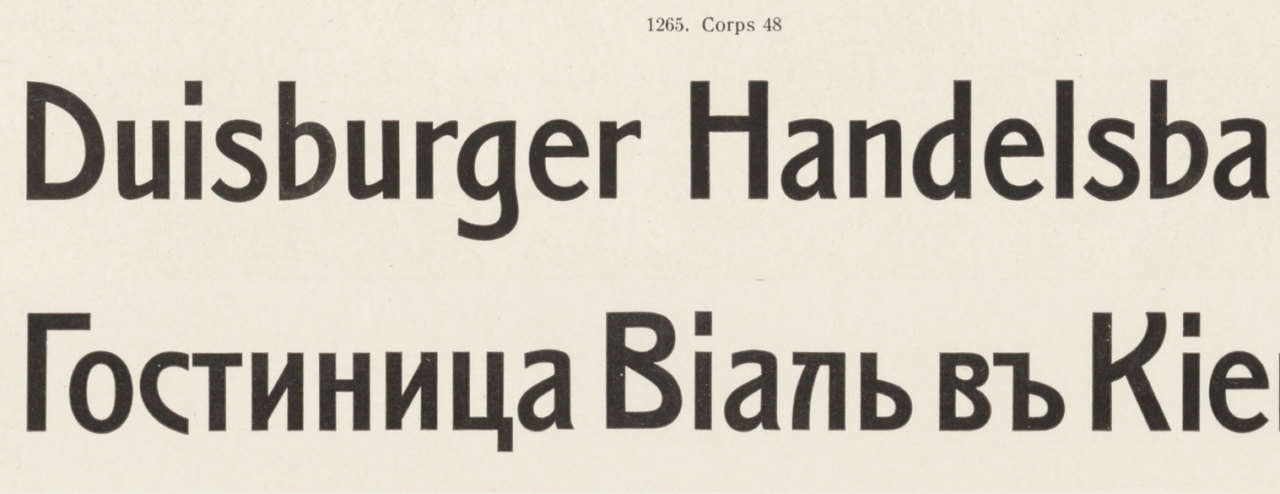
Halbfette Secession 48p.
Schreibschrift Imperial
Berthold received its German design patent for Schreibschrift Imperial from the Muster-Register on 12 February 1901. It submitted the Cyrillic characters on 26 April 1901. The St. Petersburg registration was either on 12 June 1901 as filing number 10724 or on 20 August 1901 (there are two different dates in SDTB/Hist. Archiv I.4.327 0038 NL Möllenstädt). At Berthold, Schreibschrift Imperial had the internal Garnitur-Nummer 9005.
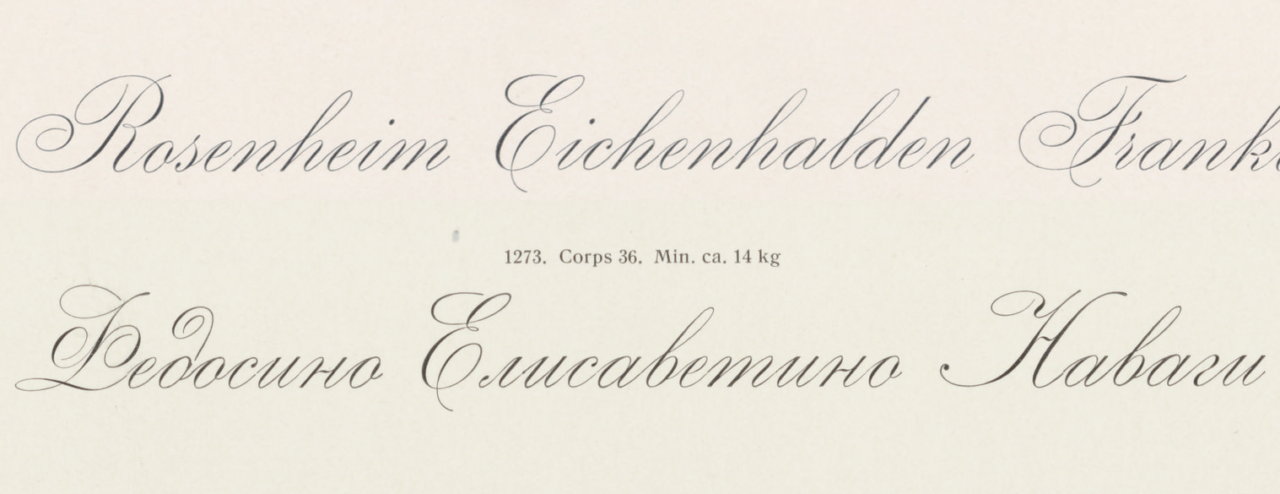
Schreibschrift Imperial 36p.
Moderne halbfette Schwabacher
A Latin-script-only design – no surprise, for a blackletter. Berthold filed its Moderne halbfette Schwabacher with the Muster-Register for a German design patent on 22 July 1901. At Berthold, Moderne halbfette Schwabacher had the internal Garnitur-Nummer 9006.

Moderne halbfette Schwabacher 36p.
Herold
Berthold also filed Herold’s Latin-script characters with the Berlin Muster-Register for a design patent on 22 July 1901. It registered the typeface’s Cyrillic on 30 November 1904. Berthold filed the design in St. Petersburg on 4 December 1904, although that registration may only have included the Cyrillic. At Berthold, Herold had the internal Garnitur-Nummer 9007.
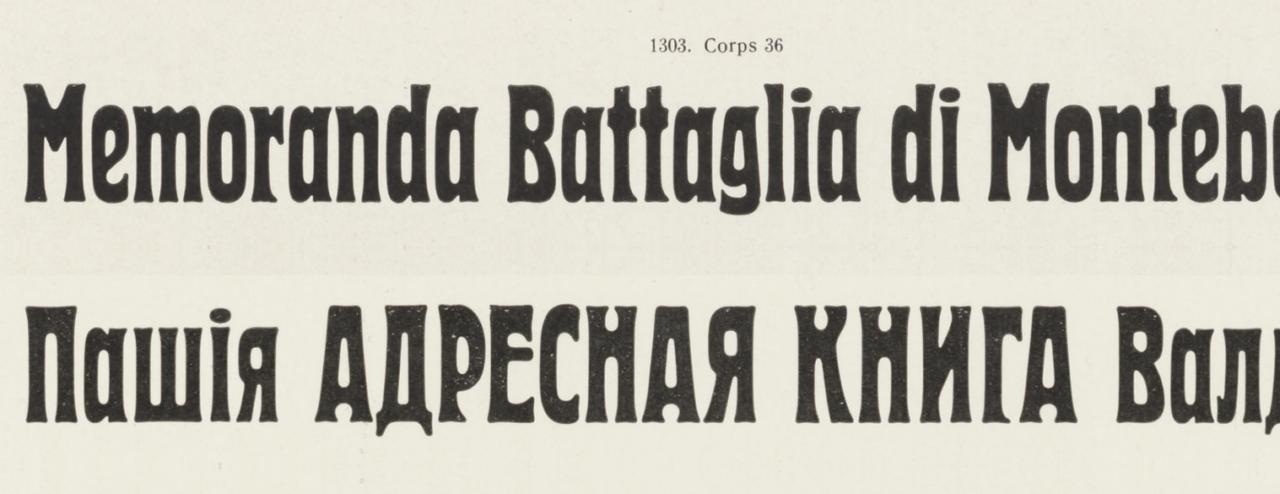
Herold 36p.
Hans Reichardt attributes the typeface’s design to Hermann Hoffmann, who had run Berthold’s internal printing office since 1895. That makes this the first typeface mentioned where we know who the type designer was, I think! Typefoundries’ in-house printing offices, or Hausdruckereien in German, often acted as the companies’ advertising departments.
Fette Antiqua
Berthold filed this Latin-script typeface with the Muster-Register on 2 July 1902. The Berthold-Schriften notebook has question marks penciled into the slots where Cyrillic-script registration dates for Germany and Russia would have been entered. At Berthold, Fette Antiqua had the internal Garnitur-Nummer 9008.

Fette Antiqua 36p.
Schmale halbfette Lateinisch
On 2 July 1902, Berthold also filed its Schmale halbfette Lateinisch with the Muster-Register. It followed up with the typeface’s Cyrillic characters on 27 August 1903. Berthold’s registration in Russia took place on 23 August 1903, as part of filing 845. Berthold submitted the typeface for an Austrian design patent on 14 September 1903. It also registered Schmale halbfette Lateinisch in Budapest on 16 September 1903. At Berthold, Schmale halbfette Lateinisch had the internal Garnitur-Nummer 9009.
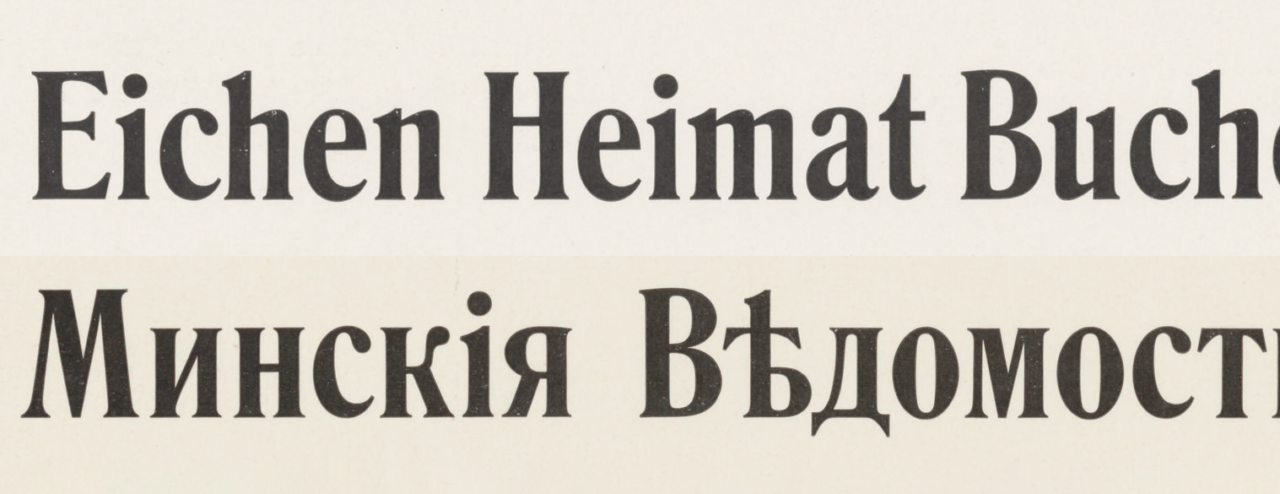
Schmale halbfette Lateinisch 48p.
Ideal-Cursiv, mager, No. 1127
The Berthold-Schriften notebook does not include German Muster-Register dates for the Magere Ideal-Cursiv type design. While I have not found the filing date for its Latin-script characters in the Deutscher Reichsanzeiger, I have found a notice of the Cyrillic there. Berthold registered it on 2 July 1902 (filing number 19,988). Magere Ideal-Cursiv’s St. Petersburg registration took place on 12 June 1902 (filing number 13713). According to the Berthold-Schriften notebook, Magere Ideal-Cursiv was a Bauer & Co. original.

Magere Ideal-Cursiv 16p.
Ideal-Cursiv, halbfett, No. 1130
The Berthold-Schriften notebook does not include German Muster-Register dates for the Halbfette Ideal-Cursiv type design. While I have not found the filing date for its Latin-script characters in the Deutscher Reichsanzeiger, I did find the Cyrillic there. Berthold registered it on 2 July 1902 (filing number 19,988). Halbfette Ideal-Cursiv’s St. Petersburg registration took place on 9 July 1903 (filing number 847). According to the Berthold-Schriften notebook, Halbfette Ideal-Cursiv was a Bauer & Co. original.
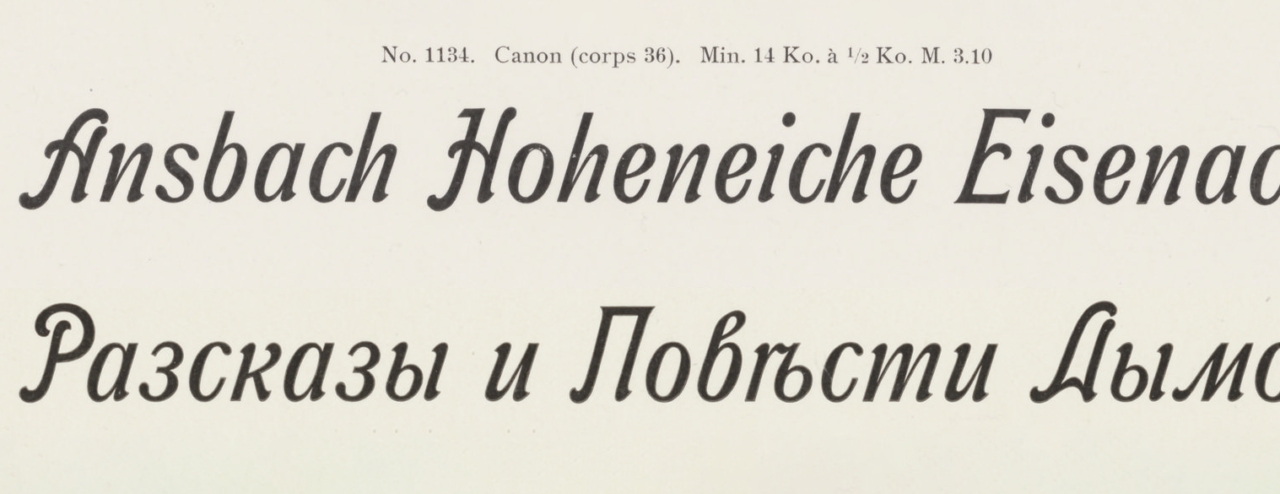
Halbfette Ideal-Cursiv 36p.
Halbfette Schreibschrift Imperial
Berthold filed Halbfette Schreibschrift Imperial with the Muster-Register for a design patent on 29 April 1902, and the Cyrillic characters followed on 22 June 1903. Berthold registered the typeface in St. Petersburg on 3 July 1903 as filing number 846. Berthold filed the typeface in Vienna on 26 June 1903 (filing #73435) and Budapest on 27 June 1903 (filing #17539). At Berthold, Halbfette Schreibschrift Imperial had the internal Garnitur-Nummer 9010.
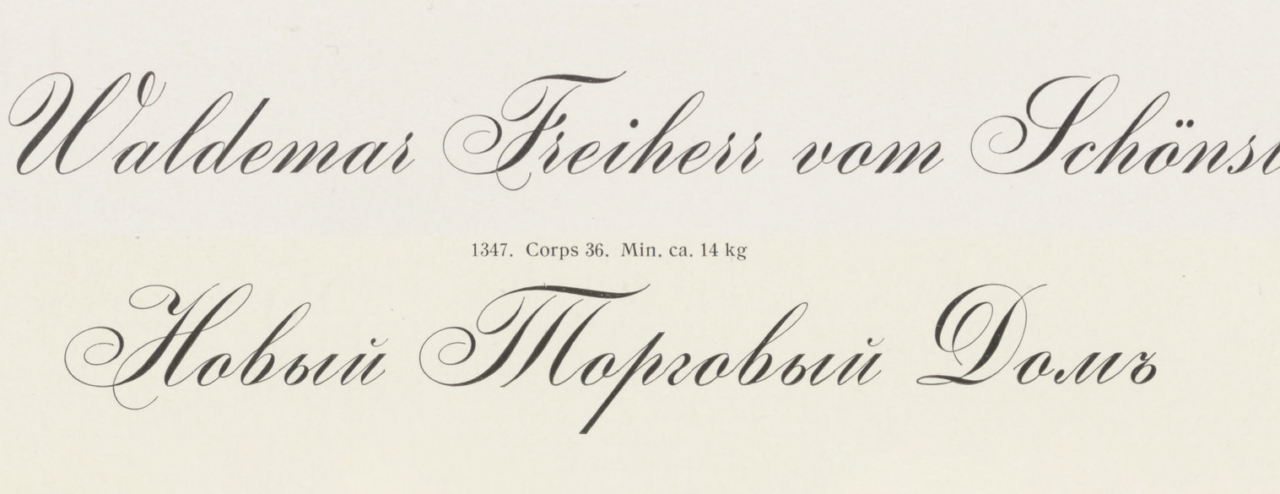
Halbfette Imperial 36p.
Circular-Grotesk Royal [Royal-Grotesk]
Before it was acquired by Berthold, Bauer & Co. in Stuttgart had a typeface called Cirkular-Grotesk, which it sold in just three sizes. That was likely cast from matrices one could trace back to the Great Western Type Foundry in the United States, which sold the design as Circular Gothic No. 44. Berthold adopted those three fonts into its program as “Circular-Grotesk.” However, the Berthold-Schriften notebook indicates that Berthold discontinued the typeface. That probably happened between 1900 and 1910; the fonts do not appear in Berthold’s large c. 1911 Hauptprobe specimen catalogs. Berthold created a similar typeface of its own, which had five more sizes. Although initially called Circular-Grotesk in the Berthold-Schriften notebook, when the foundry published the design around January 1903, it was renamed Royal-Grotesk. One of the notebook’s authors added the word “Royal” to the listing of the new Circular-Grotesk’s sizes and product numbers, although that name-addition is not accompanied by a date.
No typeface of Royal-Grotesk’s design (or name) was ever made by the punchcutter Ferdinand Theinhardt or his typefoundry, the Ferd. Theinhardt Schriftgießerei. The Theinhardt foundry did begin selling Royal-Grotesk after its acquisition by Berthold in 1908, however. Theinhardt the man and the foundry also had no involvement in the creation of Akzidenz-Grotesk; the Berthold-Schriften notebook mentions that the initial Accidenz-Grotesk weight from 1898 was a Bauer & Co. original creation.
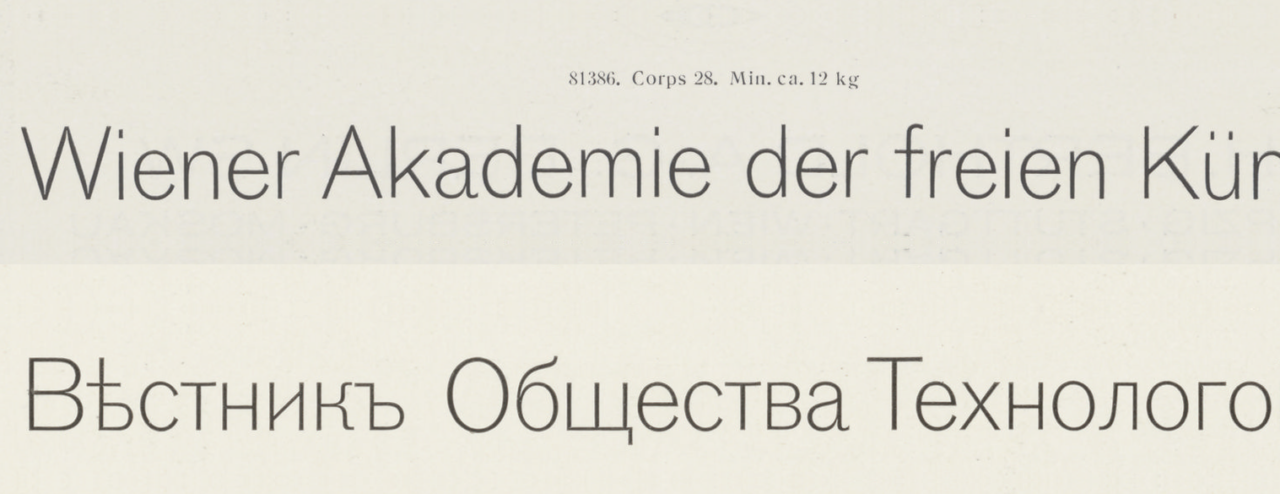
Royal-Grotesk 28p.
At Berthold, Royal-Grotesk had the internal Garnitur-Nummer 9011. Berthold registered a Grotesk Garnitur Nr. 9011 at the Berlin Muster-Register on 19 September 1902. It filed Royal Grotesk Russisch Garnitur 9011 with the city’s Muster-Register on 22 June 1903.
The Berthold-Schriften notebook does not list the Latin-script registrations for Royal-Grotesk in Vienna or Budapest, but another Berthold company notebook includes those. Royal-Grotesk was registered in Vienna on 26 November 1906, under filing number 69965. In Budapest, it was registered two days later, under filing number 16760.
According to the Berthold-Schriften notebook, Berthold’s St. Petersburg registration of Royal-Grotesk Garnitur No. 9011 was also part of filing number 846 on 3 July 1903. That submission may have been limited to Royal-Grotesk’s Cyrillic. Berthold also filed Royal-Grotesk [Cyrillic] in Vienna on 26 June 1903 (#73436) and Budapest on 27 June 1903 (#17540).
Circular-Grotesk-Cursiv Diana Aviso
Here’s another name change. I think that this design was always sold as Aviso or Aviso-Cursiv, although Berthold might have originally intended to call it “Circular-Grotesk-Cursiv” and/or “Diana.” From the type-specimen record, it was subtly advertised as an italic for Royal-Grotesk. Berthold filed the design with the Berlin Muster-Register on 23 January 1903 and submitted the Cyrillic eight months later on 27 August. It registered the design in St. Petersburg as part of filing 845 on 23 August 1903, in Vienna on 14 September 1903 (#74909), and in Budapest two days later (#17682). At Berthold, Aviso-Cursiv had the internal Garnitur-Nummer 9012.

Aviso 20p.
Princess
This Latin-script type design did not have a Cyrillic counterpart. Berthold received a German design patent on Princess from the Muster-Register on 19 September 1902. Princess had the internal Berthold Garnitur-Nummer 9013. Not to be confused with the »Kupferstich-Schrift Prinzeß« below.
Breite Grotesk-Versalien Fette Secessions-Versal
Since the name “Breite Grotesk-Versalien” is crossed out in the Berthold-Schriften notebook, it may be that Fette Secession Versal was not initially intended as part of Berthold’s Secession family. Berthold submitted Fette Secession Versal at the Berlin Muster-Register on 25 May 1903. Fette Secession Versal had the internal Berthold Garnitur-Nummer 9014.

Fette Secessions-Versal 48p.
Bücher- halbfette Grotesk
Although originally published as an independent typeface, Halbfette Bücher-Grotesk was eventually merged into the Akzidenz-Grotesk family, probably in the 1950s. Berthold submitted the Halbfette Bücher-Grotesk design to the Berlin Muster-Register on 3 August 1904. Halbfette Bücher-Grotesk had the internal Berthold Garnitur-Nummer 9015. According to another Berthold notebook at the Deutsches Technikmuseum, Berthold cut Cyrillic characters for Halbfette Bücher-Grotesk in 1912.

Halbfette Bücher-Grotesk 48p.
Record-Cursiv
Berthold filed Record with Berlin’s Muster-Register on 27 October 1903. Record had the internal Berthold Garnitur-Nummer 9016.

Record 42p on a 48p body.
Schattenschrift
Schattenschrift is a shaded extension of the Fette Secessions-Versal typeface shown above. One font can overprint the other for chromatic prints. Berthold submitted it to Berlin’s Muster-Register on 30 May 1904. Schattenschrift had the internal Berthold Garnitur-Nummer 9017.

Schattenschrift 48p.
Halbfette Augsburger Schrift
Berthold submitted the Halbfette Augsburger Schrift to Berlin’s Muster-Register on 17 September 1903. At Berthold, Halbfette Augsburger Schrift had the internal Garnitur-Nummer 9018. Hans Reichardt attributes the typeface’s design to Peter Schnorr in Stuttgart.

Halbfette Augsburger Schrift 36p.
Halbfette Mainzer Fraktur
Berthold filed Halbfette Mainzer Fraktur at Berlin’s Muster-Register on 30 May 1904. The typeface had the internal Garnitur-Nummer 9019. Based on information in the Berthold-Schriften notebook, this typeface seems to have been replaced by two Mainzer Fraktur additions published slightly later: Fette Mainzer Fraktur Garnitur No. 9036 and Breite halbfette Mainzer Fraktur Garnitur No. 9037.
FontsInUse.com cites Friedrich Bauer’s Chronik der Schriftgießereien in Deutschland und den deutschsprachigen Nachbarländern, which states that the base Mainzer Fraktur weight came from Bauer & Co. “around 1896.” Although the Berthold-Schriften notebook often mentions which Berthold typefaces originated at Bauer & Co., its entries for Mainzer Fraktur only state that the fonts were original Berthold creations.
Halbfette Aviso-Cursiv
Berthold submitted Halbfette Aviso-Kursiv to Berlin’s Muster-Register on 7 October 1904. The typeface had the internal Berthold Garnitur-Nummer 9020.

Halbfette Aviso 36p.
Schmale Herold
Berthold filed Schmale Herold with the Berlin Muster-Register on 25 February 1904. Schmale Herold had the internal Garnitur-Nummer 9021. Hans Reichardt attributes the typeface’s design to Hermann Hoffmann, who is also credited with having designed Herold’s regular-width version.

Schmale Herold 36p.
Secession Kontur
Berthold submitted Secession Kontur to the Berlin Muster-Register on 14 October 1904. The typeface had the internal Berthold Garnitur-Nummer 9022.

Secession Kontur 36p.
Herold Kontur
Berthold submitted Herold Kontur to the Berlin Muster-Register on 1 October 1904. The typeface had the internal Garnitur-Nummer 9023. Hans Reichardt attributes the typeface’s design to Hermann Hoffmann.

Herold Kontur 36.
Corinna
Berthold filed the Corinna typeface with the Berlin Muster-Register on 21 November 1904. Corinna had the internal Berthold Garnitur-Nummer 9024.
FontsInUse.com notes that Hans Reichardt found “a showing in Deutscher Buch- und Steindrucker” in which this design was named Virgil. The type-size listings for Corinna in the Berthold-Schriften notebook confirm this as the original name. Based on what is printed in the Deutscher Reichsanzeiger, Berthold’s submission of the design to Berlin’s Muster-Register may not have included a typeface name. Under filing number [1904] 22,556, the notice in the newspaper only included the number 9024.

Corinna 36p.
According to a notice than ran in Deutscher Reichsanziger four years later, Berthold submitted Corinna’s Cyrillic script characters at the Berlin Muster-Register on 23 October 1908 as part of filing number [1908] 26,609. Corinna’s Cyrillic was filed with an un-named typeface bearing the Garnitur-Nummer 9040. According to the Berthold-Schriften notebook, Garnitur-Nummer 9040 was assigned to Block. Hans Reichardt attributes Block’s design to Hermann Hoffmann.
Prinzess
Berthold filed Kupferstich-Schrift Prinzeß with the Berlin Muster-Register on 7 July 1905. The Kupferstich-Schrift-Prinzeß had the internal Garnitur-Nummer 9025.

Kuperstich-Schrift Prinzeß 24p.
FontsInUse.com calls Kuperstich-Schrift Prinzeß “an open version of Gutenberg-Gotisch, issued by Bauer & Co. as Gutenberg-Gotisch licht.” Gutenberg-Gotisch was one of Bauer & Co.’s first typefaces, cut by Friedrich Wilhelm Bauer and Theodor Friebel in the early 1880s. The Berthold-Schriften notebook simply attributes Kupferstich-Schrift Prinzeß as an “Original-Schnitt.” It refers to the Gutenberg-Gotisch fonts as “Original Bauer & Co.” creations.
Halbfette Augustea
Berthold submitted Halbfette Augustea at the Berlin Muster-Register on 28 March 1906. Halbfette Augustea had the internal Garnitur-Nummer 9026.

Halbfette Augustea 36p.
Halbfette Sorbonne
Berthold filed Halbfette Sorbonne with the Berlin Muster-Register on 16 March 1906. Halbfette Sorbonne had the internal Berthold Garnitur-Nummer 9027.

Halbfette Sorbonne 48p.
Sorbonne was Berthold’s version of ATF’s Cheltenham typeface.
Halbfette Corinna
Berthold submitted Halbfette Corinna to the Berlin Muster-Register on 1 November 1906. Halbfette Corinna had the internal Garnitur-Nummer 9028.

Halbfette Corinna 36p.
Enge fette Fraktur Kaufhaus Fraktur
Berthold filed Kaufhaus-Fraktur with the Berlin Muster-Register on 29 December 1906. Kaufhaus-Fraktur had the internal Garnitur-Nummer 9029. Hans Reichardt attributes the typeface’s design to Hermann Hoffmann.

Kaufhaus-Fraktur 36p.
Fette Secession
Berthold registered Fette Secession with the Berlin Muster-Register on 30 January 1907. Fette Secession had the internal Garnitur-Nummer 9030.

Fette Secession 36p.
Initialen zur Sorbonne-Cursiv (Sorbonne-Circular)
According to the Berthold-Schriften note book, Berthold filed a series of initials for Sorbonne-Cursiv with the Berlin Muster-Register on 10 December 1906. That entry does not make much sense to me. Elsewhere in the notebook, the Sorbonne-Circular typeface itself is given the same Garnitur-Nummer (9031), as it also is on this specimen page. And while Berthold specimens include do initials for Sorbonne, I have not found any for Sorbonne-Cursiv/Circular.
Fette Herold
Berthold registered Fette Herold with the Berlin Muster-Register on 19 April 1907. At Berthold, Fette Herold had the internal Garnitur-Nummer 9035. Hans Reichardt attributes the typeface’s design to Hermann Hoffmann.

Fette Herold 36p.
Fette Herold is the last Garnitur-Nummer that the Berthold-Schriften the Berthold-Schriften notebook provides design registration information for, at least until an author begins recording data 14 years later. By consulting registration notices printed in the Deutscher Reichsanzeiger, it will eventually be possible to add at least the German design patent filings for those few dozen “missing” type designs. But first, the newspaper digitization’s OCR results will need to be improved.
Interlude until 1921
Presumably, the Berthold-Schriften notebook lists all typefaces Berthold published between 1907 and 1921. It simply does not have design registration for them. The first Berthold typeface from the interwar years to have that information is Schwere Block.
Schwere Block
Berthold submitted Schwere Block at the Berlin Muster-Register on 1 September 1922. The typeface had the internal Garnitur-Nummer 9073. Hans Reichardt attributes the typeface’s design to Hermann Hoffmann.

Schwere Block 36p.
Fette Berthold-Fraktur
Berthold filed Fette Berthold-Fraktur the Berlin Muster-Register on 14 September 1921 and in Vienna on 5 October 1921. The foundry gave its typeface the internal Garnitur-Nummer 9074.

Fette Berthold-Fraktur 48p and 60p.
Schmale ½fette Berthold Fraktur
Berthold filed Schmale halbfette Berthold-Fraktur with Berlin Muster-Register on 19 September 1921 and in Vienna on 5 October 1921. The foundry gave its typeface the internal Garnitur-Nummer 9075.

Schmale halbfette Berthold-Fraktur 48p and 60p.
Schmale fette Berthold Fraktur
Berthold also filed Schmale fette Berthold-Fraktur with the Berlin Muster-Register on 19 September 1921 and in Vienna on 5 October 1921. The foundry gave its typeface the internal Garnitur-Nummer 9076.

Schwere Block-Fraktur
Berthold filed Schwere Block-Fraktur with Berlin Muster-Register on 14 September 1921 and in Vienna on 5 October 1921. The foundry gave its typeface the internal Garnitur-Nummer 9077.

Schwere Block-Fraktur‘s design is very close to the Bauersche Gießerei’s Extrafette Bernhard-Fraktur, from Lucian Bernhard. That typeface was also published in 1921. Extrafette Bernhard-Fraktur and Schwere Block-Fraktur were very bold extensions to pre-WWI Fraktur typefaces. Bernhard-Fraktur came to market first. It was originally published by the Flinsch typefoundry, which the Bauersche Gießerei acquired during the First World War. Block-Fraktur was designed by A. Froescher, who also drew an even-lighter Fraktur face in a related style. Berthold sold that as Stuttgarter Fraktur. I have not found a source attributing Schwere Block-Fraktur to any particular designer, although it is not inconceivable that Froescher might have drawn it for Berthold, too.
Halbfette Block-Russisch
Berthold submitted its Cyrillic typeface Halbfette Block-Russisch to the Berlin Muster-Register on 5 November 1921. It also registered the Cyrillic characters for an Austrian design patent on 19 January 1922. Berthold gave Halbfette Block-Russisch the internal Garnitur-Nummer 9078.

Halbfette Block-Russich 48p and 60p.
Alt-Mediaeval-Kursiv
Berthold filed the Alt-Mediaeval-Kursiv typeface with the Berlin Muster-Register on 29 October 1921. The foundry gave Alt-Mediaeval-Kursiv the internal Garnitur-Nummer 9079.

Alt-Mediaeval-Kursiv 36p.
Alt-Mediaeval-Kursiv and the earlier upright Alt-Mediaeval typeface were designed for Berthold by Max Hertwig.
Münchener Barock-Einfassung Enge-Journal-Antiqua
Based on the crossed-out text in the Berthold-Schriften notebook, Berthold may have originally intended to use the Garnitur-Nummber 9080 for a »Münchner Barock-Einfassung«. Instead, however, it used it for the Enge Journal-Antiqua typeface. Originally, Enge Journal-Antiqua was designed by another Berlin typefoundry, Emil Gursch. Berthold acquired the Gursch foundry after the First World War and added the Journal typefaces into its own typeface program. On 16 January 1922, Berthold filed Enge Journal-Antiqua with the Berlin Muster-Register.

Heinz Reichardt suggests that Hermann Zehnpfundt designed Enge Journal-Antiqua along with the other Journal family typefaces.
Schmale fette Journal-Antiqua
Berthold filed Schmale fette Journal-Antiqua with the Berlin Muster-Register on 16 January 1922. The typeface had the internal Garnitur-Nummer 9081. Hans Reichardt attributes the design to Hermann Zehnpfundt.

Schwere Industria
Berthold also submitted Schwere Industria to the Berlin Muster-Register on 16 January 1922. Like Journal-Antiqua, the Industry typefaces were products that came to Berthold with its acquisition of the Emil Gursch typefoundry. Berthold gave Schwere Industria the internal Garnitur-Nummer 9082. Hans Reichardt attributes the design to Hermann Zehnpfundt.

Schwere Industria 38/42p.
Nova-Mediaeval
I assume that this entry is for Berthold’s Nova typeface. In any event, the typeface that the Berthold-Schriften notebook describes as Nova-Mediaeval was filed with Berlin’s Muster-Register on 15 August 1922. Berthold submitted the design in Vienna two days later. According to the Berthold-Schriften notebook, this typeface had the internal Garnitur-Nummer 9083.

Nova 60/48p.
Schmale Block
Berthold filed the Schmale Block design at Berlin’s Muster-Register on 16 September 1922. It also registered the design in Vienna on 19 September 1922. Schmale Block had the internal Garnitur-Nummer 9084. Hans Reichardt attributes the typeface’s design to Hermann Hoffmann.

Schmale Block 48p and 60p.
Block-Russich
Berthold submitted the Cyrillic-script Block-Russisch typeface at Berlin’s Muster-Register on 24 November 1922 and at Vienna’s on 23 November1922. It had the internal Berthold Garnitur-Nummer 9085.

Block-Russisch 48p and 60p.
Schwere Block-Russisch
There was also a Schwere Block-Russisch, which Berthold filed with the Berlin Muster-Register on 17 May 1923 and in Vienna on 23 May 1923. Berthold gave Schwere Block-Russisch the internal Garnitur-Nummer 9086.

Schwere Block-Russisch 48p and 60p.
Nova-Mediaeval-Kursiv
This entry must be for Berthold’s Nova-Kusiv. In any event, the typeface that the Berthold-Schriften notebook describes as Nova-Mediaeval-Kursiv was filed with Berlin’s Muster-Register on 8 September 1923 and 11 September 1923 in Vienna.According to the Berthold-Schriften notebook, this typeface had the internal Garnitur-Nummer 9087.

Nova-Kursiv 48p.
Fette Nova-Mediaeval
Likewise, this must be Fette Nova. The typeface the Berthold-Schriften notebook describes as Fette Nova-Mediaeval was also filed with Berlin’s Muster-Register on 8 September 1923 and 11 September 1923. According to the Berthold-Schriften notebook, it had the internal Garnitur-Nummer 9088.

Fette Nova 72/60p.
Schmale Block-Russisch
Berthold submitted Schmale Block-Russisch to Berlin’s Muster-Register on 13 October 1924. It also filed the design in Vienna on the same day. Schmale Block-Russisch had the internal Garnitur-Nummer 9089.

Schmale Block-Russisch 48p and 60p.
Halbfette Lo
Berthold also filed its Halbfette LO-Schrift with the Berlin and Vienna Muster-Register on 13 October 1924. The “LO” in the name Halbfette LO-Schrift stood for Louis Oppenheim, who designed the typeface. At Berthold, the Halbfette LO-Schrift had the internal Garnitur-Nummer 9099.

Halbfette LO-Schrift 48p.
Magere Lo
The Magere LO-Schrift was yet another typeface Berthold submitted to the Berlin and Vienna Muster-Register on 13 October 1924. It had the internal Garnitur-Nummer 9091. Louis Oppenheim designed the typeface.

Magere LO-Schrift, 48p.
Schrift Plastik
I don’t know what typeface “Schrift Plastik” is. It isn’t Plastica (Garnitur-Nummer 9152c); the Berthold-Schriften notebook suggests that Plastica was finished or published on 20 December 1935. In any event, whatever “Schrift Plastik” was, Berthold filed it with the Berlin Muster-Register on 17 December 1924. It had the internal Garnitur-Nummer 9092.
Sebaldus-Gotisch
Berthold submitted Sebaldus-Gotisch with the Berlin Muster-Register on 31 January 1925. It filed the design in Vienna on 3 February 1925. At Berthold, Sebaldus-Gotisch had the internal Garnitur-Nummer 9093.

Sebaldus-Gotisch 48p.
Sebaldus-Gotisch‘s design looks very similar to Wiking, a typeface Heinz König drew for J. D. Trennert & Sohn in Altona. Like Sebaldus-Gotisch, Wiking was published in 1925. According to a letter in the Klingspor Museum that Hartmut Harmening sent to Hans Halbey, Sebaldus was the working name at Gebr. Klingspor for Rudolf Koch’s Wilhelm-Klingspor-Schrift – at least until the death of Wilhelm Klingspor (1871–1925). A 16p proof at the museum corroborates this. The Wilhelm-Klingspor-Schrift was also published in 1925.
Arabisch 1
Berthold submitted an Arabic-script typeface it referred to as Arabisch 1 to the Berlin Muster-Register on 26 March 1925. It filed the typeface in Vienna on 30 March 1925. The typeface had the internal Garnitur-Nummer 9094.
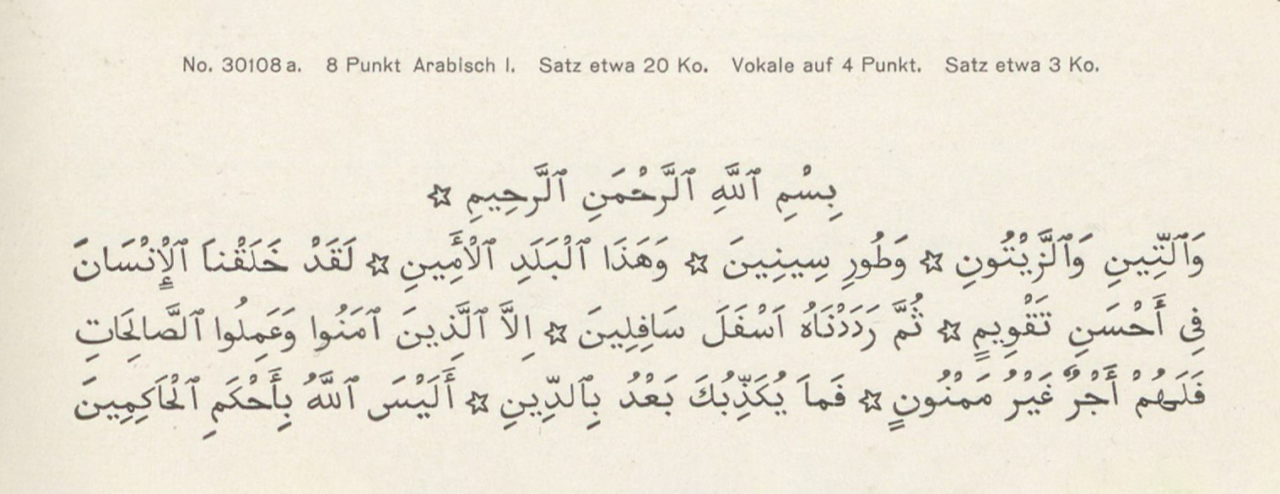
Arabisch I 8p.
Norm-Akzidenz-Grotesk
In 1924, Berthold began adapting three type styles from the Akzidenz-Grotesk family for the Normenausschuß der deutschen Industrie (today, the Deutsches Institut für Normung). From Enge Akzidenz-Grotesk, Berthold developed the Engschrift. The Mittelschrift, also called Norm-Akzidenz-Grotesk, was derived from Akzidenz-Grotesk’s regular weight/width. Breite Akzidenz-Grotesk was adapted into the Breitschrift. These designs are the ancestors of the later DIN-Schriften. Berthold submitted Norm-Akzidenz-Grotesk to the Berlin Muster-Register on 5 November 1925. The next day, Berthold filed Norm-Akzidenz-Grotesk with the Vienna Muster-Register. At Berthold, Norm-Akzidenz-Grotesk had the internal Garnitur-Nummer 9095.
Straßburg-Gotisch
Berthold filed Straßburg with the Berlin Muster-Register on 26 January 1926. It registered the typeface in Vienna the next day. Berthold gave Straßburg the internal Garnitur-Nummer 9096.

Straßburg 48p and 60p.
Enge Akzidenz-Grotesk-Russisch
Berthold submitted Enge Akzidenz-Grotesk-Russich to the Berlin and Vienna Muster-Register on 22 March 1926. The typeface had the internal Garnitur-Nummer 9097.

Enge Akzidenz-Grotesk-Russisch 28p and 36p.
Halbfette Akzidenz-Grotesk-Russich
On the same day, Berthold also filed Halbfette Akzidenz-Grotesk-Russich with the Berlin and Vienna Muster-Register. Halbfette Akzidenz-Grotesk had the internal Garnitur-Nummer 9098.

Halbfette Akzidenz-Grotesk-Russisch 48p and der 60p.
Fette Augustea-Kursiv
Berthold submitted Fette Augustea-Kursiv at the Berlin Muster-Register on 16 April 1926. The next day, it filed the design in Vienna. Berthold gave the typeface the internal Garnitur-Nummer 9099.

Fette Augustea-Kursiv 28p and 36p.
Arabisch 2
Berthold filed its Arabisch 2 typeface at the Berlin Muster-Register on 6 May 1926. On 7 May 1926, Berthold registered the type design in Egypt and Austria. Arabisch 2 is the only design-patent registration mentioned in the Berthold-Schriften notebook made outside of Europe. At the foundry, Arabisch 2 had the internal Garnitur-Number 9100.

Arabisch II 10p.
Recta-Kursiv
Berthold submitted Recta-Kursiv to Berlin’s Muster-Register on 9 August 1926. On the 14th, Berthold filed the design in Vienna. The typeface had the internal Garnitur-Nummer 9101.

Recta-Kursiv 28p.
Berliner Grotesk Russisch
Berthold also brought its Berliner Grotesk Russisch typeface to the Muster-Register in Berlin on 9 August and to Vienna’s on 14 August 1926. Berliner Grotesk Russisch had the internal Garnitur-Nummer 9102.

Berliner Grotesk Russisch 28p and 36p.
Enge Block
Berthold’s Enge Block was brought to Berlin’s Muster-Register on 20 December 1926. It submitted the design in Vienna the next day. Enge Block had the internal Garnitur-Nummer 9103. Hans Reichardt attributes the typeface’s design to Hermann Hoffmann.

Enge Block 48p and 60p.
Fanfare
Berthold filed Fanfare with Berlin’s Muster-Register on 25 April 1927. The foundry submitted the design in Vienna two days later. Berthold gave the typeface the internal Garnitur-Nummer 9104. Louis Oppenheim designed the typeface.

Fanfare 48p and 60p.
Schmale Fanfare
A note for Schmale Fanfare in the Berthold-Schriften notebook mentions that Berthold never registered a design patent for it, “because one Garnitur (No. 9104) is sufficient for the design protection.” Schmale Fanfare had the internal Garnitur-Nummer 9105.

Schmale Fanfare 48p and 60p.
Block-Kursiv
Berthold submitted Block-Kursiv at Berlin’s Muster-Register on 2pm 5 August 1927. The typeface was filed in Vienna on 1 September 1927. It had the internal Garnitur-Nummer 9106. Hans Reichardt attributes the typeface’s design to Hermann Hoffmann.

Block-Kursiv 48p and 60p.
Jacobea
Berthold filed Jacobea with the Berlin Muster-Register on 11 October 1927. In Vienna, it submitted Jacobea the next day. Jacobea had the internal Garnitur-Nummer 9107. Martin Jacoby-Boy designed the typeface.

Jacobea 28p and 36p.
Schattierte Arabisch
Berthold submitted its Arabische Schattenschrift to Berlin’s Muster-Register on 2 February 1928 and Vienna’s on 3 February 1928. At the foundry, this typeface had the internal Garnitur-Nummer 9108.

Arabische Schattenschrift 48p
Rundfunk
Berthold filed the Rundfunk typeface at Berlin’s Muster-Register on 7 July 1928. On 13 July 1928, it submitted the design in Vienna. Rundfunk had the internal Garnitur-Nummer 9109. Adolf Behrmann designed the typeface.

Rundfunk 36p and 48p.
Flamingo
Berthold submitted Flamingo for an Austrian design patent on 30 March 1928. According to the Berthold-Schriften notebook, it did not file Flamingo with Berlin’s Muster-Register until 29 August 1928. I would not be surprised if there was a clerical error in this typeface’s information. Numbers are usually used for months in the notebook, and a 3 can easily be written instead of an 8 if one is not careful. I have not yet been able to verify this registration with listings in the Deutsche Reichsanzeiger yet. At Berthold, Flamingo had the internal Garnitur-Nummer 9110. Louis Oppenheim designed the typeface.

Flamingo 60p.
Berthold-Grotesk Magere
Berthold filed Magere Berthold-Grotesk with Berlin’s Muster-Register on 31 October 1928. It submitted the design in Vienna on 2 November 1928. The typeface had the internal Garnitur-Nummer 9111.

Magere Berthold-Grotesk 48p.
Berthold-Grotesk
Berthold also submitted Berthold-Grotesk in Berlin and Vienna on the 31st of October and the 2nd of November 1928, respectively. The typeface had the internal Garnitur-Nummer 9112.

Berthold-Grotesk 48p.
Schmale enge Journal-Antiqua
This entry leaves me baffled. I have no idea what the Schmale enge Journal-Antiqua is. I have not been able to find a specimen for it. The Berthold-Schriften notebook has an entry for it, calling it Garnitur-Nummer 9113. But no registration information is included.
Stam (Hebräisch)
Berthold filed the Hebrew-script Stam typeface with the Berlin Muster-Register on 10 January 1929. It submitted the design in Vienna two days later, and in Warsaw on January 19th. Stam had the internal Garnitur-Nummer 9114. Franzisca Baruch designed the typeface.
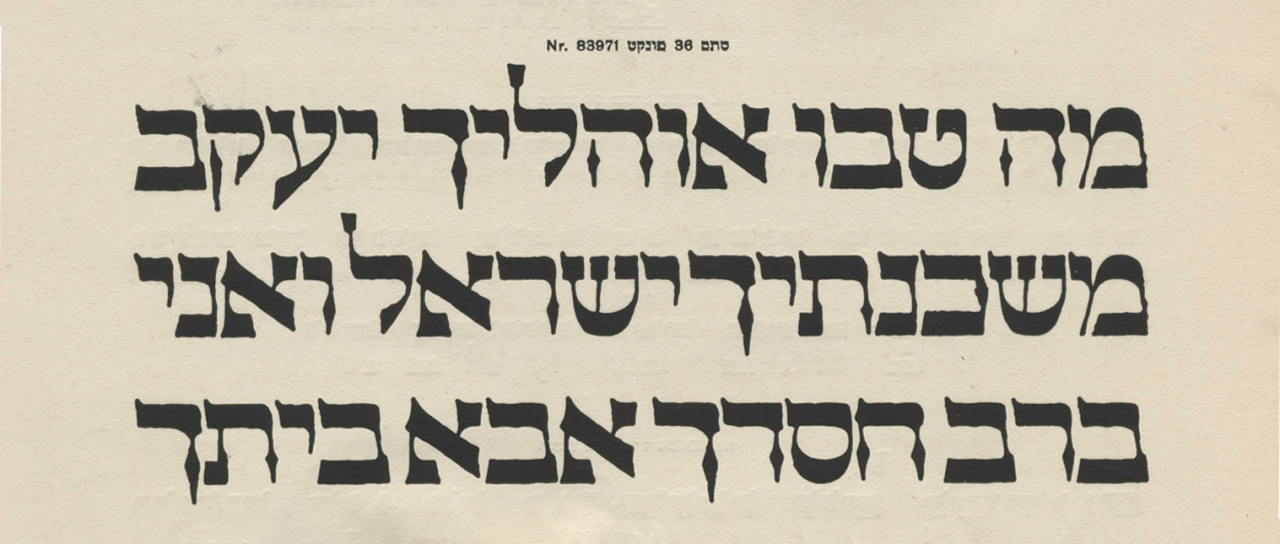
Stam 36p.
Fette Berthold Grotesk
Berthold also submitted the Fette Berthold-Grotesk at the Berlin Muster-Register on 10 January 1929. It filed the design two days later in Vienna as well. Berthold submitted the typeface in Warsaw on 22 March 1929. Fette Berthold-Grotesk had the internal Garnitur-Nummer 9115.

Fette Berthold-Grotesk 48p.
Karten-Gotisch
I have not been able to find a specimen of the typeface, although I’ve seen it listed in the table of contents of Berthold’s Register-Probe specimen. The Karten-Gotisch sheet is not in any Register-Probe I’ve seen. Berthold filed the design with the Berlin Muster-Register on 10 January 1929. Like Stam and Fette Berthold-Grotesk, it was submitted in Vienna two days later. Karten-Gotisch had the internal Garnitur-Nummer 9116.
Rachel (Hebräisch)
Berthold submitted its Hebrew-script typeface Rachel to the Berlin Muster-Register on 30 January 1929. You can see a specimen of Rachel on the right-hand side of this spread. The typeface was filed in Vienna on 4 February and in Warsaw on 22 March 1929. Rachel had the internal Garnitur-Nummer 9117.

Rachel 36p.
Rambam (Hebräisch)
Berthold submitted its Hebrew-script Rambam typeface in Berlin, Vienna, and Warsaw on the same days as Rachel (above). You can see a specimen of Rambam on the left-hand side of this spread. Rambam had the internal Garnitur-Nummer 9118.

Rambam 36p.
Lichte Flamingo
Berthold filed Lichte Flamingo at the Berlin Muster-Register on 11 February 1929. It submitted the design in Vienna on 13 February and in Warsaw on 22 March 1929. Lichte Flamingo had the internal Garnitur-Nummer 9119. Louis Oppenheim designed the typeface.

Lichte Flamingo 48p and 60p.
Radio-Versal
According to the Berthold-Schriften notebook, this Adolf Behrmann design was not registered. Radio-Versal had the internal Garnitur-Nummer 9120.

Radio-Versal 48p.
Radio
Berthold filed Radio at the Berlin Muster-Register on 4 February 1930. It submitted the design in Vienna two days later, and in Warsaw on 31 March 1930. Radio had the internal Garnitur-Nummer 9121. Hans Reichardt attributes the design to Adolf Behrmann.

Radio 48p.
Graublock
Berthold submitted Graublock to the Berlin Muster-Register on 6 March 1930. It filed the typeface in Vienna the next day, and in Warsaw on 31 March 1930. Graublock had the internal Garnitur-Nummer 9122.

Graublock 96/84p.
City fett
Berthold filed Fette City with the Berlin Muster-Register on 15 March 1930. It submitted the typeface in Vienna two days later, and in Warsaw on 31 March 1930. Fette City had the internal Garnitur-Nummer 9123. Georg Trump designed the typeface.
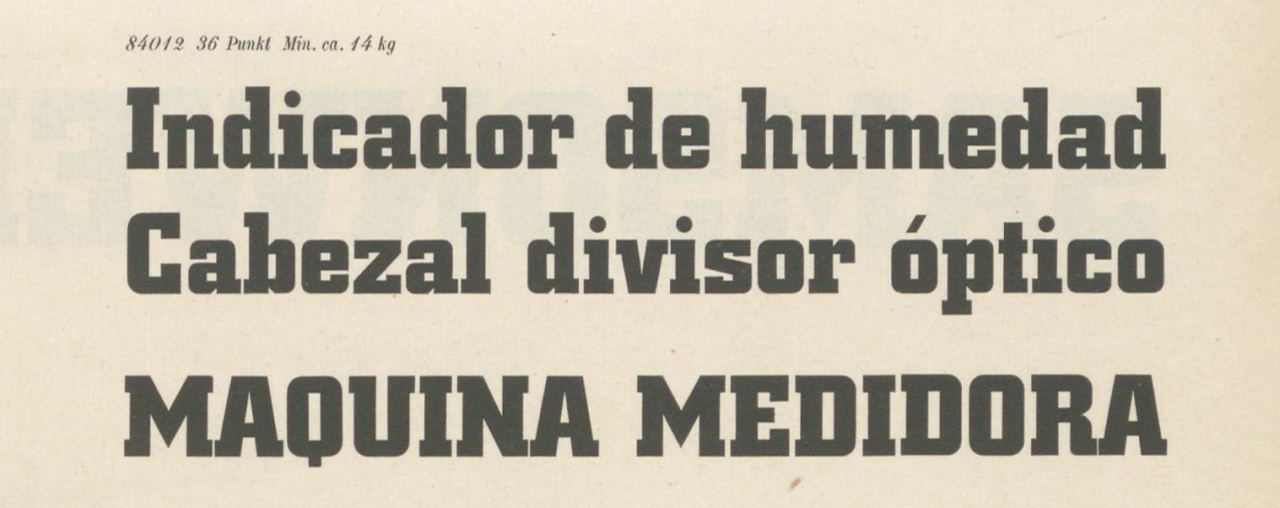
Fette City 36p.
City halbfett
Berthold submitted Halbfette City to the Berlin Muster-Register on 19 August 1930. The typeface was filed in Vienna on 5 September and in Warsaw on 27 October 1930. Halbfette City had the internal Garnitur-Nummer 9124. Georg Trump designed the typeface.
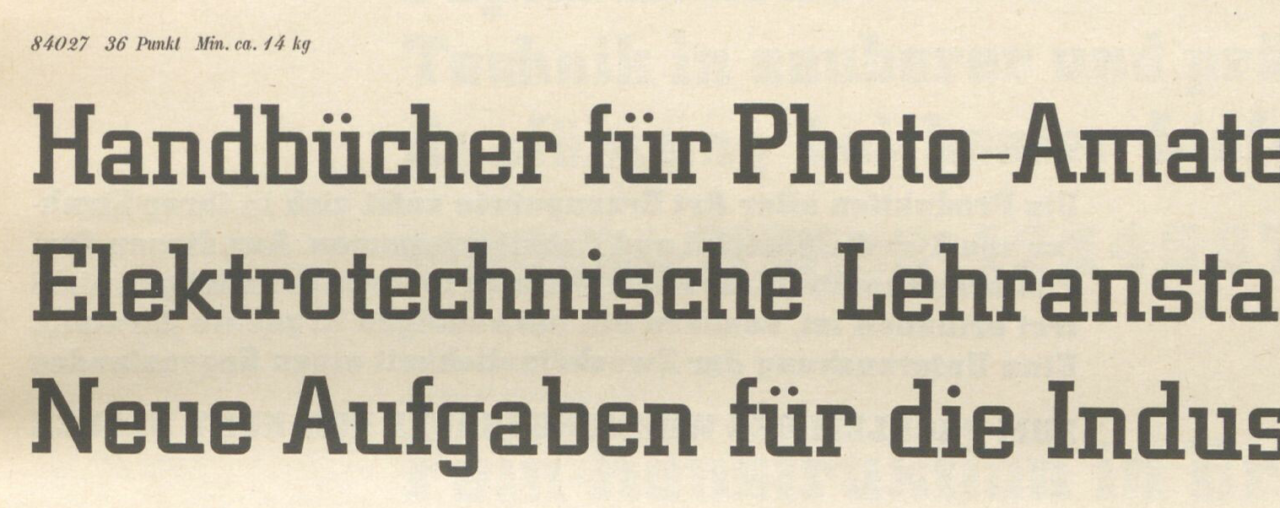
Halbfette City 36p.
Magere Berthold-Grotesk-Kursiv
Berthold filed Magere Berthold-Grotesk-Kursiv in Berlin, Vienna, and Warsaw on the same days as Halbfette City. Magere Berthold-Grotesk-Kursiv had the internal Garnitur-Nummer 9125.

Magere Berthold-Grotesk-Kursiv 48p.
Berthold-Grotesk-Kursiv
Berthold also filed its Berthold-Grotesk-Kursiv typeface at the Berlin Muster-Register submission on 19 August 1930. The typeface also was submitted in Vienna on 5 September and in Warsaw on 27 October 1930.. Berthold-Grotesk-Kusiv had the internal Garnitur-Nummer 9126.

Berthold-Grotesk-Kursiv 48p.
Signal
The Berthold-Schriften notebook only includes a Viennese registration date for Signal. Berthold filed it there on 23 January 1931. Signal had the internal Garnitur-Nummer 9127. Walter Wege designed the typeface.

Signal 48/36p.
Signal is the last typeface for which the Berthold-Schriften notebook provides design-registration details.
After 1931
There are 45 more Garnitur-Nummern listed after Signal in the Berthold-Schriften, all without any registration details.
